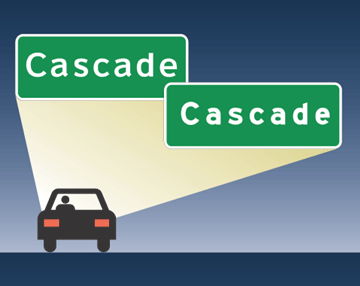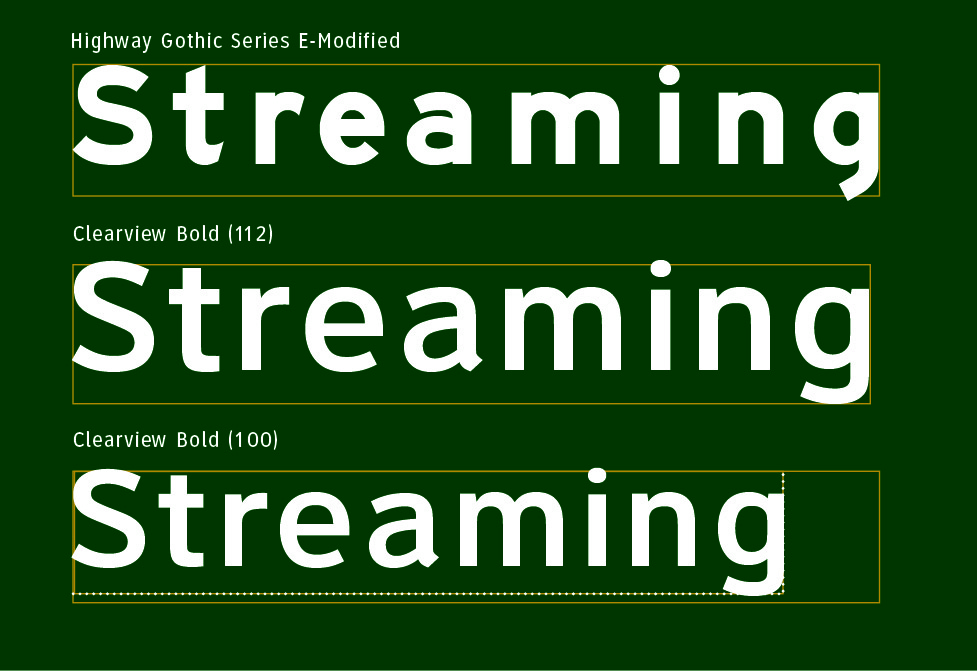


Traditionally, in California and some other states, laminated panel signs have been used, which consist of a core of wadded paper (or other fill material folded into a concertina shape to make it stiff) between two sheets of aluminum. The terms "laminated panel" and "formed panel" also need some explanation. This is an example of the strip-style tab: This approach can be used for formed panel signs but tends to be more common for ground-mounted laminated panel signs. * Strip-style-tab is outside the border of the main sign panel, but both panel and tab are on the same rectangular sign panel, which means there is a strip of unbordered green background running from the exit tab to the opposite vertical edge of the sign. The previously posted I-215 Riverside/San Bernardino sign is an example of the bitten-out tab style. * Bitten-out-tab patched onto the upper-right (for right-hand exits) or upper-left (for left-hand exits) corner of the main sign panel this or the strip style (see below) is necessary for formed-panel signs because there is no provision to attach tabs to the formed panels or to the removable sign panel frame which holds them. This is very rarely used in California (the only examples I am aware of are all in Caltrans District 2, which covers far northeastern California, and most if not all of them have been done by drilling through ground-mounted laminated panel signs to attach mounting hardware for exit tabs). * Conventional-separate tab attached to the main sign panel, as in the other 49 states. There are basically three officially approved ways of affixing the exit tabs (the labels which follow are my own invention and not official nomenclature): Since California opted out of the federal requirement to have exit tabs for more than 30 years (from 1971 to 2002), exit tabs have had to be retrofitted to freeway guide signs in California and the process is still ongoing. But, unlike TxDOT and Arizona DOT, PennDOT rarely does "pure" sign replacement contracts-usually signs are changed out as part of resurfacing work.Īlso, is the exit number part of the main sign because the same sign in real life has no exit number, not even on a separate panel above. In practice a sign can comply with this requirement only if it is illuminated or has retroreflective sheeting over its entire surface, and these old laminated signs have non-reflective background panels and button frames (only the buttons in the button copy, which are made of clear plastic and are arrays of cut-corner prisms similar to bicycle reflectors, are retroreflective). These old signs are endangered because they can't comply with the current MUTCD requirement that a sign have substantially the same appearance by night as it does by day. However, AFAICT, Interstate shields (no text designations) were always used on these signs. The usual design practice for these signs called for centered exit tabs with no bottom border, and state and US route designations in text only ("PA" and "US" at a smaller letter height than the digits). Those are old laminated-panel signs with reflective button letters.
#CLEARVIEW FONT HIGHWAY SERIES#
I have seen recent signing plans using both Clearview and Series E Modified coming out of PennDOT, so I don't think it falls into this category.
#CLEARVIEW FONT HIGHWAY PLUS#
The rare true believers ("Clearview to be used on all future signing," plus systematic replacement of old signing using Series E Modified in either reflective lettering or button copy) include TxDOT and Arizona DOT. (Local agencies and turnpike authorities are a different matter the KTA has at least one Clearview sign already, while Franklin County in Ohio and the city of Oakland in California have moved toward Clearview.) As an example, California, Kansas, and Ohio all have Clearview IAs, but (judging from pattern-accurate signing plans) Caltrans, KDOT, and Ohio DOT are continuing to use Series E Modified on their infrastructure and show no signs of wholesale conversion to Clearview. At this stage, the states which are making a complete conversion to Clearview appear to be a minority of those who have obtained an interim approval to use Clearview from FHWA.


 0 kommentar(er)
0 kommentar(er)
